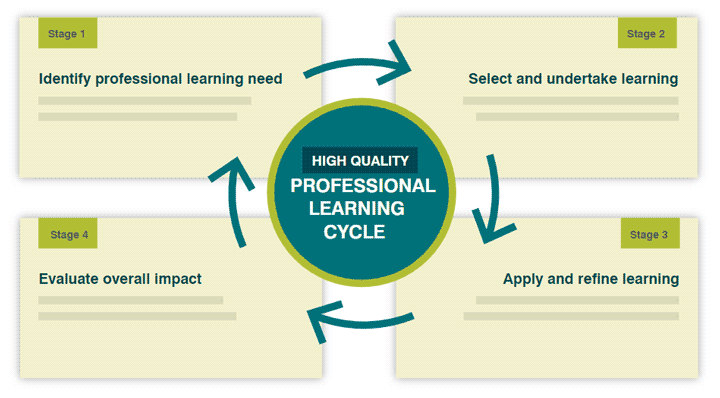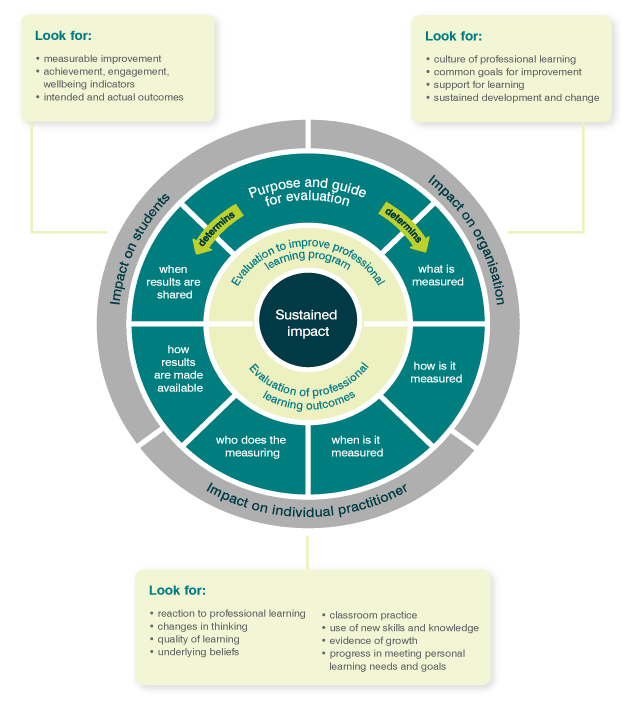Whether you are a teacher or a leader, effective professional learning follows a continuous learning cycle. The HQPL Cycle sits alongside the Framework with a focus on ongoing professional learning and growth, rather than performance reviews or appraisals.
Teachers are encouraged to use the HQPL cycle throughout the year. The HQPL Cycle is enabled by strong support from leaders and a strong culture of continuous development.

The stages in the cycle are interwoven and may differ according to a teacher’s learning needs and the type of professional learning being undertaken.
Activity for teachers
Reflection
What information do you generally consider when identifying professional learning to engage in? How does this compare to your colleagues?
How do your education setting’s current priorities for improvement influence your own goals for professional learning?
How do you consider the current needs of your learners when reflecting on your professional learning goals?
When selecting and undertaking professional learning, you should ensure it is aligned to the Australian Professional Standards for Teachers (the Standards). When engaging with a learning provider, they should identify which of the Standards focus areas
the session is geared towards. You can then check this against your goals to make sure they align.
Reflection
How do you consider different types of professional learning to select the most suitable one for your learning need(s)?
What types of professional learning do you most commonly engage with; both individually and with your colleagues?
How successfully does your professional learning challenge your thinking and enhance your practice? Why or why not?
After you’ve selected and undertaken professional learning (or while you are continuing to undertake it) you need to apply the learning to your education setting context.
Tips for applying and refining learning:
- Focus on learning strategies you can implement immediately and evaluate in the following weeks.
- You may have to tweak elements to best suit your learners and their context.
- It takes time to become proficient at new strategies, so engage in regular cycles of learning, observation, and review to support and track your progress.
- Seek feedback at key points. This might be from learner data, inviting other teachers to observe the new strategies in action, or discussing what you’ve learnt.
Sometimes the initial professional learning may just be an introduction to a topic, and you may find you need more detail and practical strategies to apply it to the classroom.
Reflection
Reflecting on professional learning you have engaged in recently, what outcomes did you hope to achieve?
What actions did you take to apply that learning within your everyday practice?
Can you identify a time you refined and changed your practice over time as you applied new learning? What information did you consider that guided you to modify your practice incrementally?
There are many approaches to evaluating professional learning. Measuring effectiveness from multiple viewpoints will provide you with a well-rounded picture.

Evaluating is more than deciding if the professional learning was interesting or not. Careful planning and evaluating can help you make decisions about ongoing professional learning and the effects of the changes made to your practice.
Evaluating can take place during and following the learning process.
Reflection
What approaches do you take to monitor whether your professional learning is helping you to improve your practice?
What processes exist at your education setting to help you monitor the impact of changes you make to your practice? For example, what is your approach to sharing your learning experience and evaluation with colleagues?